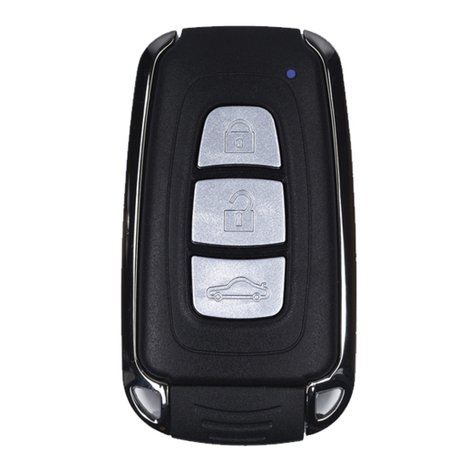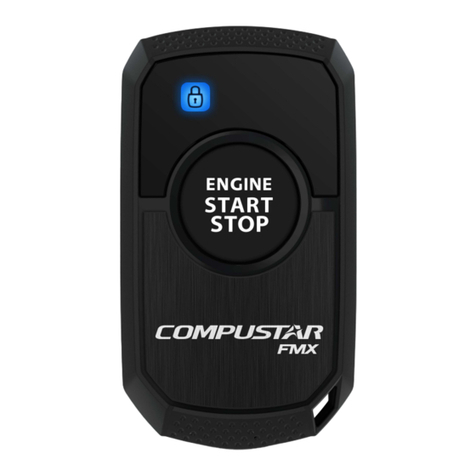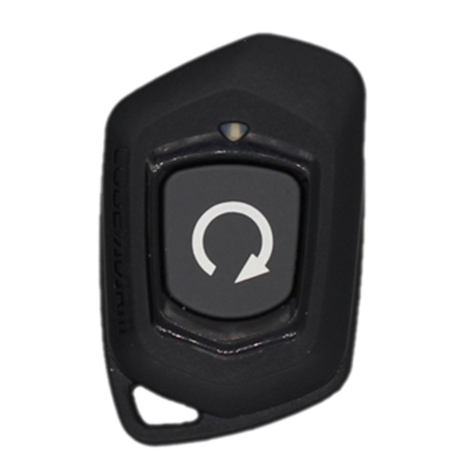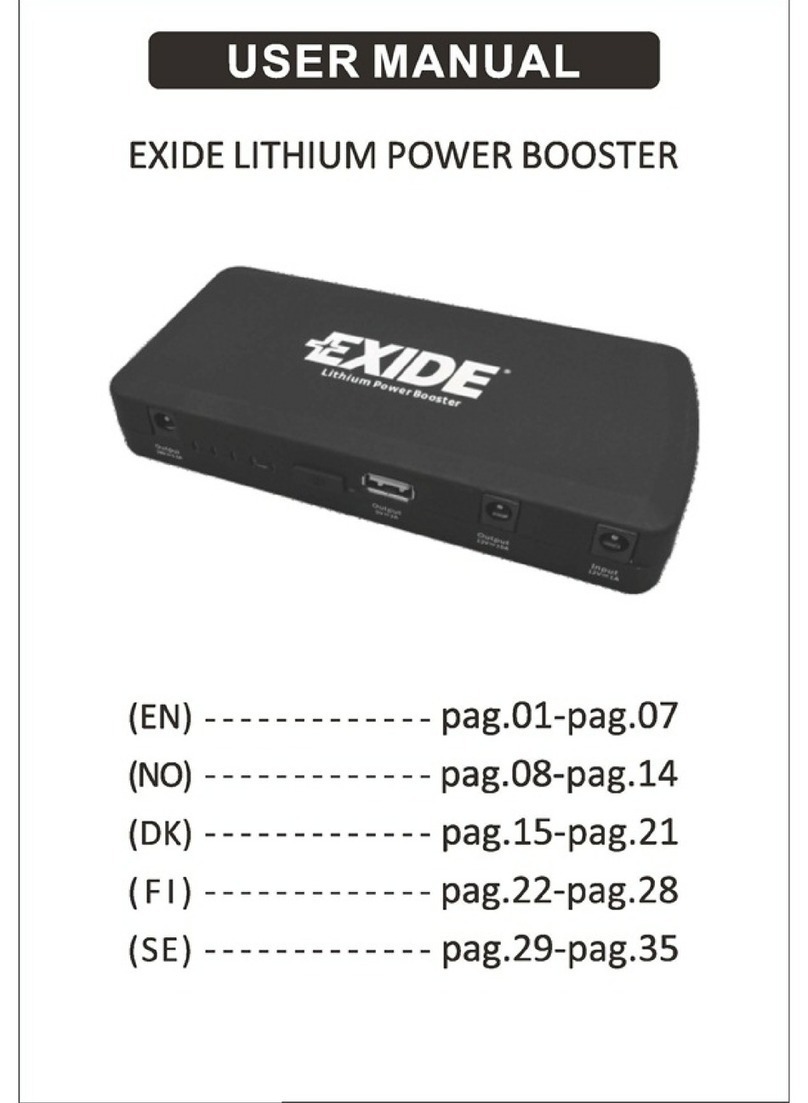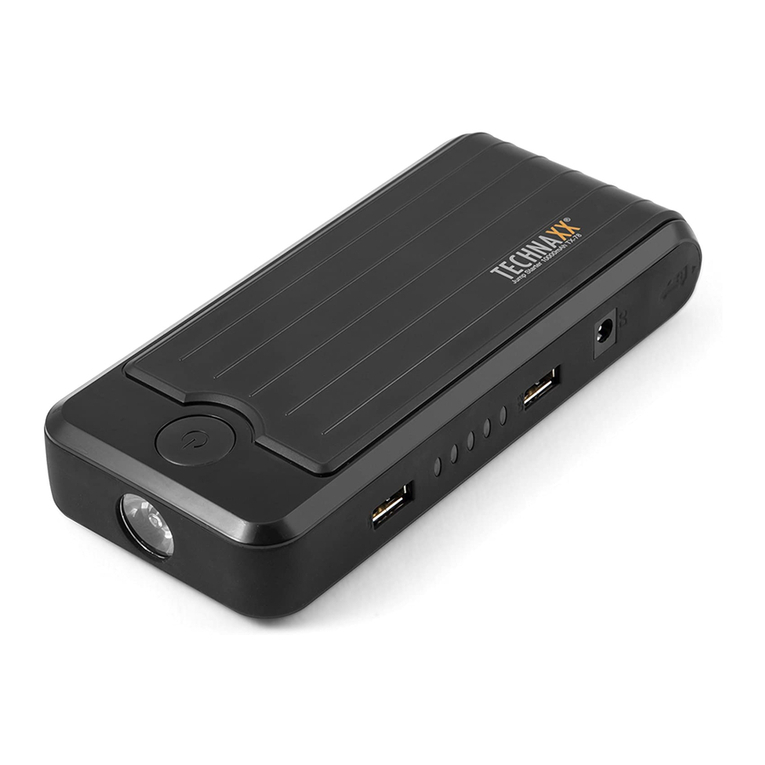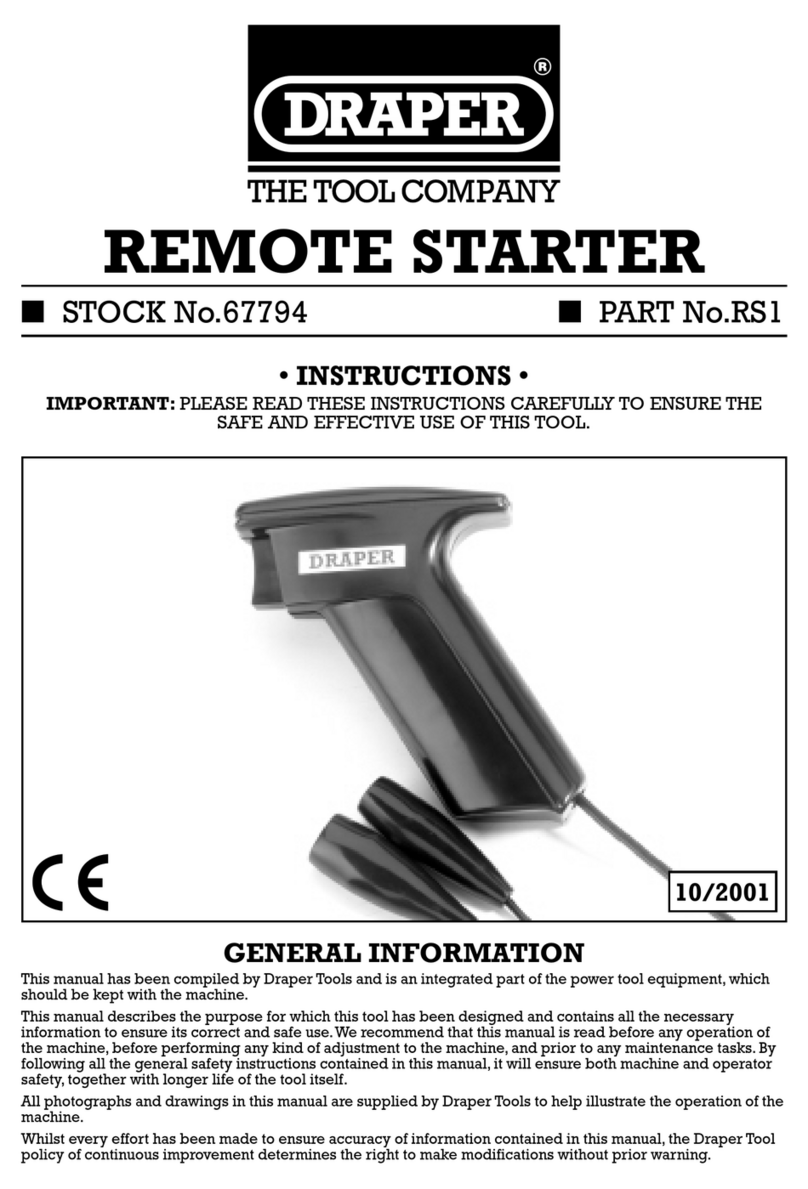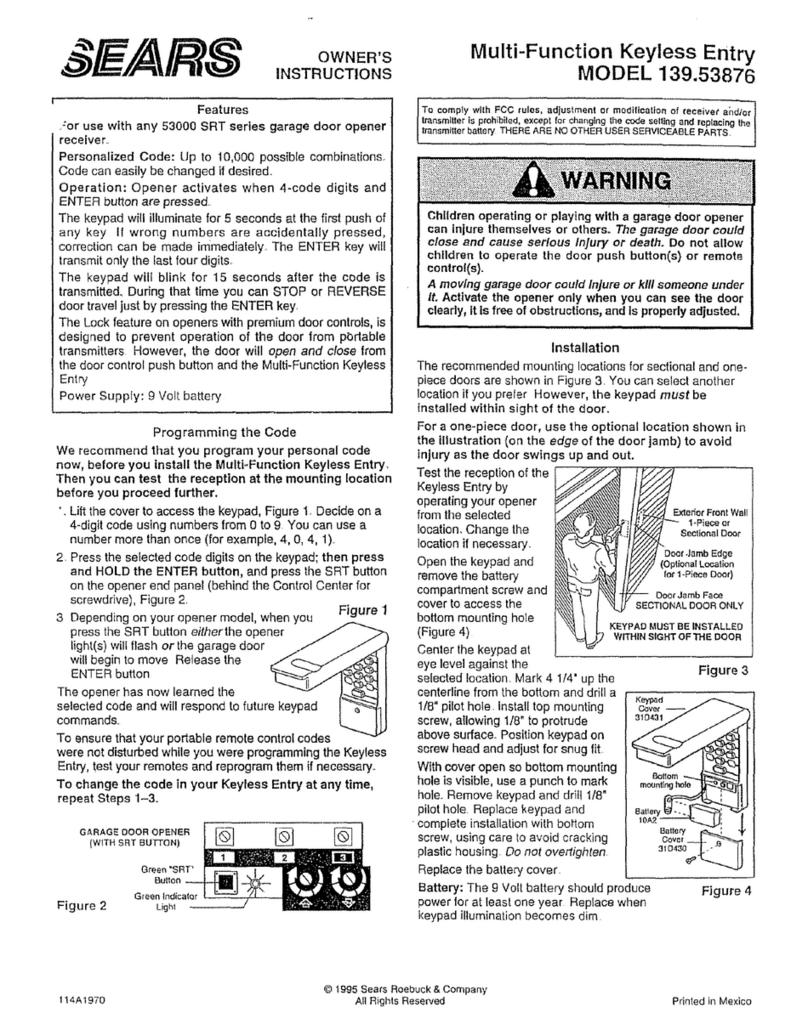Digital Guard Dawg 2GO KEYLESS iKEY RS Operation manual


2
Package Contents ………................................................. 4
Pre-Installation Information and Preparation ..................5
Major Component information….....................................6
Part #1 PKE Passive Keyless Door Lock & Alarm…............8
Door Lock & Alarm Module (Harness Connections).......9
Door Locking System Wiring............................................ 11
Door “Open” Triggers.................................................... 13
Antenna Installation ………...............................................15
Function Jumper Set & External Siren Diagram...........16
Door Lock Wiring Diagram Appendix “A” & “B”…………….……… 25
PKE Module Wiring Diagram …………….……….... 27
Part #2 PBS Push Button & Remote Start...................17
Different Types of Push Button Start Installations...........18
Push Button Start Module (Harness Connections).....20
Start Button Dimensions.........................................24
Push Button Start Wiring Diagram ………….……… 28
Push Button Start High Current Wiring Diagram….……… 29
Basic System Operation.........................................30

3
IMPORTANT
1) This product must be installed by a qualified professional
according to these instructions and observing all safety features.
2) The Digital Guard Dawg Inc. accepts no responsibility for any
electrical damage resulting from improper installation of the
product, be that either damage to the vehicle itself or to the
product.
3) Before starting ensure the vehicle to be installed has proper
grounding and no electrical shorts.
4) Completely read the Product Installation Guide carefully before
beginning any work.
FCC NOTICE
This device complies with part 15 of the FCC Rules. Operation is subject to the
following two conditions: 1. This device may not cause harmful interference,
and 2. This device must accept any interference received, including interference
that may cause undesired operation. FCC WARNING This equipment has been
tested and found to comply with the limits for a Class B digital device, pursuant
to Part 15 of the FCC Rules. These limits are designed to provide reasonable
protection against harmful interference in a residential installation. This
equipment generates uses and can radiate radio frequency energy and, if not
installed and used in accordance with the instructions, may cause harmful
interference to radio communications. The manufacturer is not responsible for
any radio or TV interference caused by unauthorized modification to this
equipment. Such modifications could void the user’s authority to operate the
equipment.

4
The 2GO KEYLESS™ PKE- & PBS systems come in individual boxes. The
following is a list of components included with each kit:
PKE Door Lock & Alarm Kit:
1 – Door Lock & Alarm Control Unit
1 – RFID iKey™
1 – RFID Emergency Card
1 – Door Lock & Alarm Main Harness - 7 PIN
1 – Door Lock & Alarm Accessory Harness - 7 PIN
2 – Front Main Antennas
1- Antenna “Y” adaptor
1 – Emergency Backup Antenna
1 – Dual Color Dash Mounted LED Indicator
Push Button Start Kit:
1 – Push Button Start Control Unit
1 – Push Start Button
1 – Push Button Main Harness - 8 PIN
1 – Push Button Accessory Harness - 10 PIN
1 –Installation Guide / User Manual

5
Overview:
Completely read this manual and review the wiring diagram carefully.
It is recommended that you complete your installation in two parts.
Part 1~Installation of the Door Lock and Alarm module & Harnesses.
Part 2~Installation of the Push Button–Remote Start & Harnesses.
1. Always install in a well-lit, dry, covered area away from the elements and keep
at least one window open during installation to avoid a lock out.
2. Locate necessary wires related to the installation (most required wires are
under driver dash or kick panel areas). Use only a digital multi-meter to verify
signal wires. Please be aware of surrounding metal and prevent accidental
grounding of wires through various tools being used during the installation
process.
3. Disconnect the ground wire (-) terminal from the vehicle’s battery prior to
making ANY connections. To avoid accidents, it is recommended to remove
related fuses from sockets before making connections and put them back
during the very last steps.
4. Mount the Control Module in a secure area, away from vehicle computers and
heating/air conditioning ducts. The location should be convenient for your
installation, but well hidden from thieves. Try to mount the unit as far away from
metal objects to increase the range of the iKey™ Transmitter.

6
5. Route the wires of the harnesses along factory wiring to areas in which the
different connections will be made. DO NOT plug the two wiring harnesses into
the Control Module until all connections have been completed. When running
the harness wires through the vehicle, be careful to run them where they could
be damaged or shorted to GROUND. Keep them away from ALL MOVING
PARTS of the vehicle or where high heat could damage their insulation. Always
protect the harness wires where they pass through holes in metal panels by
using rubber grommets. Secure wires to factory harnesses using zip ties and
use wire loom where appropriate.
6. Once the control unit is connected, begin function tests only after verifying and
ensuring all wires have been connected and insulated properly. Do not power
up the module before it is properly grounded. If the unit is powered before
being grounded, serious damage to internal components could occur.
Immobilizer and Data Interfaces
Many vehicles on the road manufactured after 1995 utilize some form of factory
security that requires a code that is passed between the key and the vehicle.
Different manufacturers use different methods to incorporate this into the ignition
cylinder of which RF or a key (or cylinder) impregnated resistor is the most popular.
These types of security are in place to disable the “cranking” of the motor and are
known as Immobilizers.
Data Interfaces have become popular with aftermarket products as obd2 and
CANbus interfaces have evolved over the last 15 years. Aftermarket Data
Interfaces utilize analog wire signals from 2GO-Keyless™ system and translate
them into data that the vehicle can use to lock / unlock doors, monitor door open /
closed status, etc. In many cases Data Interfaces and Immobilizers are combined
into one unit and are manufactured by various aftermarket companies.
In vehicles manufactured after 1995 an Immobilizer or Data Interfaces module
may be necessary for the installation of Keyless Entry and Push Button Start of the
vehicle while maintaining all factory features. This manual will serve only as a
general guide to the installation of the 2GO-Keyless™ system, consideration of
Immobilizer or Data Interfaces devices and their installation should be done by a
professional.
If you need assistance locating an Immobilizer or Data Interfaces device for your
vehicle contact us at (877) 2GO-KEYLESS or 877- 246- 5395

7
Control Module and Push Button Start Module: Select a mounting location
behind the dash, and secure using cable ties. Be certain that the chosen location
will not interfere with the proper operation of the vehicle. Avoid mounting the
module to or routing the wiring around the steering column, as the module or wiring
could wrap around or block the steering wheel preventing proper control of the
vehicle. Do not mount the modules in the engine compartment, as it is not
waterproof.
Start Button: The system Start Button is used to control your Start, ON, ACC &
STOP modes of your vehicle’s ignition system. In addition, the Start Buttons LED
provides a visual indication of when the system has recognized a valid RFID iKey™
and when the vehicle is ready to be started. Typically the Start Button is installed in
the dash or center console of the vehicle, but it can be installed in any location
within the length of the buttons 32” harness. Your choice of Start buttons will
determine the diameter and depth of hole needed for button installation. Be sure
and confirm that your have ample room behind the dash for the type Start Button
you have choose. Specific Start Button dimensions can be found on page 24 of this
manual.
Dash Mounted LED: A dual color (Red / Blue) LED is also included in this kit. It
is a secondary visual indicator of the system mode. This LED is not required to be
used, but if installed will indicate when the systems alarm features Arm and Disarm,
as well as provide a “Flashing” warning to notify wood be thieves that your vehicle is
protected. If installing this LED, locate it where it can be easily seen from outside
the vehicle, yet not be distracting to the driver. Once a location has been selected,
check behind the panel for wire routing access, and confirm the drill will not damage
any existing components as it passes through the panel. Drill a 19/64” (7.6mm)
hole, and pass the wires from the LED through the hole, from the front of the panel.
Firmly press the body of LED into the hole until fully seated.
(Optional) Siren: If you are installing a Siren instead of connecting to the
vehicle’s OEM horn, you will need to open the control module case and change the
systems jumper set (JP4) according the wiring diagram. * for more information see
“Jumper Sets” page 16. Always mount the Siren away from heat sources such as
radiators, exhaust manifolds and turbochargers. Mount it in an area where it will not
be in the way for mechanics and so that it cannot be easily reached from below the
vehicle. Mount it so that its sirens opening points down to prevent it from collecting
water.

8
The Door Lock and Alarm Module will provide completely automatic operation of all
vehicle doors and all security functions.
PKE Module iKey™
As you approach your vehicle doors will unlock upon seeing a valid iKey™.
Walk away from the vehicle, all doors auto lock and security features arm
Installation should begin with selecting a location to mount the system module
and locating of all signal wires listed below. Once a location has been selected,
mount the Door Lock / Alarm module and connect wires according the systems
wire diagram.

9
Connect the Ground wire first before making the 12-volt connections to the
Module. Powering up before grounding could damage the system!
PKE Door Lock & Alarm ~ Main Harness (7-Pin)
Use wire color for identification, Actual wire order in harness m ay be different.
Wire Description
1 Red ( + )
12V
Battery
Connect to the 12V supply wire of the Ignition harness. Ensure that the
OEM power wire is fuse is more than 15A.
Note: certain new vehicles have no suitable 12 volt source at the
IGNITION switch (the 12 Volt wire is too small to supply the
necessary current). In this case, the fuse box, or the B+
connection on the battery is recommended.
2 Black
Chassis
Ground
( - )
This wire is the system Ground and must be connected to bare,
unpainted metal Chassis or true Body ground. It is preferable to use a
factory ground bolt rather than a self-tapping screw. Screws tend to
get loose or rusted over time and can cause erratic problems.
3
Gray
(2 Wires)
Parking
Light
This wire is provided to flash the vehicle’s parking lights. Connect one
gray wire to the output side of one of the vehicle’s parking lights. Or
use both gray wires to connect to the L & R turn indicator wires. If only
one wire is required, remove fuse and terminate second gray wire
appropriately.
4
Purple
(-) OE Horn
or Siren
Connect to the vehicle’s OEM horn or to an external Siren. Connect
directly to NEGITIVE side of vehicle’s horn control wire or connect to a
siren using the diagram on page 16 of this manual. The control wire will
usual be under the steering wheel and should be negative when honk.
5
Blue
(-) Unlock
If you have a negative-trigger central locking system, directly connect
this wire to the door UNLOCK signal wire.
Please refer to page 11 for more information on other central locking
system trigger types. If a Data Interface is used, connect to
modules “Door Output Status wire”.
6
Green
(-) Lock
If you have a negative-trigger central locking system, directly connect
this wire to the door LOCK signal wire.
Please refer to page 11 for more information on other central locking
system trigger types. If a Data Interface is used, connect to
modules “LOCK” input wire.
7
Brown
Trunk
Release (-)
500mA negative output This output is used to control Trunk release
(1-sec. pulse) and operates only when Ignition is OFF.

10
Door Lock & Alarm ~ Accessory Harness (7-Pin)
Wire Description
1
Red
Vehicle ON Detect
(+)
This wire is for sensing when the vehicle is ON. It should be
connected to an Ignition wire that has +12 V when the Ignition
Key or Push Button Start is in the and ON (RUN) position.
Special instructions when using Remote Starter: Connect to
different ACC wire if the vehicle has 2nd ACC.
2
Green
Door Trigger
Default
(-) Negative
This wire senses when a vehicle “door open status”. If you
have a negative-trigger door switch system, you can directly
connect this wire to the door switch signal wire.
If you have a positive–trigger or are not sure, refer to page 13 for
more information on door switch system trigger types. Note:
Default function setting is Negative door switch. Change PKE
modules jumper (JP1) to Positive when vehicles use positive-
switch Dome Light circuit.
If a Data Interface is used, connect to modules “UNLOCK” input
wire.
3
Blue
Connects to Window Rollup Module “Optional”
4
Brown
(+) Brake
This wire senses when you step on the Brake. The wire will be
+12V as you depress the brake pedal, and will be ground when
release brake.
5
Purple
This wire provides the data control signal for the 2GO-Keyless™
Push Button – Remote Start Module. Connect this wire to the
(Purple) input signal wire of the Push Button Start module.
6
White
OE Alarm
Factory Disarm
output (-)
If needed, this wire can provides a Ground when Armed or
Disarmed signal that can be used as a “Factory Disarm Wire” for
a OEM Alarm system
7
EMPTY

11
All power door locking systems utilize switches or a central computer called the
Body Control Module (BCM) to control the locking and unlocking of the vehicle.
The switch is usually located on the door or center console while the BCM is
usually located under the Dash. Most locking systems will have at least 2
control wires, one for locking your doors called the LOCK wire, and one for
unlocking your doors called the UNLOCK wire.
You can refer to your vehicle’s electrical service manual for details on location
and color coding of Locking/Unlocking wires or you can find them by tracing the
wires from the door switches. Remember to only use a Digital Multi Meter when
testing for vehicle wires.
When testing a wire to "lock", your LOCK wire establishes a
connection to either a negative or a positive source, this will be the
signal to your vehicle to trigger a locking signal to the door lock
actuator or BCM to lock. Vice versa if you are testing for “unlock”.
Negative and Positive triggers are the two main types of door locking systems.
On a negative trigger system your LOCK and UNLOCK wire uses (-) negative
sources to signal the vehicle when you activate unlock or lock. In a positive
trigger system, your LOCK and UNLOCK wire uses (+) positive sources to
signal the vehicle when you activate unlock or lock.
Certain Manufactures such as Dodge/Chrysler utilize a single wire system
called a multiplexer. This single control wire uses one wire in combination with
resistor values to communicate to the BCM to LOCK and UNLOCK the vehicle.
Please refer to Appendix B Figure 2.

12
Aftermarket Data Interfaces
If an aftermarket Data Interface is being used, please refer to its manual. The
interface may be able to LOCK and UNLOCK the door using the data wires of the
vehicle. The Vehicle’s Receiving (RX) and Transmission (TX) wires can be referred
to in the Data Interface’s manual. In order to use this feature the systems LOCK
(Green) and UNLOCK (Blue) wires must be connected to the Data Interface’s
LOCK and UNLOCK input. DO NOT USE BOTH THE VEHICLE AND DATA
INTERFACE’S INPUTS. USE ONLY ONE AS DAMAGE MAY OCCUR.
There are various types of central locking systems please verify and
confirm the type of door locking system either by digital multimeter
and/or through your vehicle’s dealer technical support department.
Diagrams for making connections for each of the different types of
door locking systems are shown in Appendix “A”

13
Negative or Positive Door Trigger
The Green wire in the 7 PIN Accessory harness is used to sense when a
vehicle door is open. It will need to be connected to your vehicle’s dome light
circuit or individual door triggers. Generally, most vehicles have an overall
signal wire which will trigger a signal no matter which door is opened. Door
triggers can be either Negative (GM and most Imports) or positively triggered
(most Fords and some Imports).You can refer to your vehicle’s electrical
service manual for details on location and color coding of the Dome Light or
Door Trigger wire(s). Remember to only use a Digital Multi Meter when testing
for vehicle wires.
Three different connections may be made to determine the Vehicle’s Door
Status.
(1) The Dome Light is a simple circuit of two wires that illuminate a bulb once
any door opens on the vehicle. Various Manufacturers also have dome lights
that do not immediately turn off once all vehicle doors are closed. In this case,
when Dome Light Delay is present, it is preferable to use an alternate means to
determine the Door Status.
(2) Door Pin Switches are used in many vehicles and their associated wires can
be typically found in the driver’s kick panel or near the BCM. If multiple wires
are used to determine “Door Status” connections to the 2GO Keyless™ PKE
must be independently isolated to each wire to prevent damage to BCM
(Appendix B Fig 2).
(3) Data Interfaces can also be used to determine Door Status by using the RX
and TX lines of the vehicle while the interface provides an output to the green
door status wire.

14
Once the proper connection type is determined verify the type of door trigger for
your vehicle. After locating the proper wire, shut off the interior lights first, then
open the driver side’s door, keeping the other doors closed; Then check the
voltage, if the voltage is ground with the door open and becomes positive
voltage when the door is closed, then it is a negative trigger type. Conversely, if
the voltage is positive with the door open and ground when closed, then the
door is a positive trigger type. This type of test can be used on the Dome Light
connection as well as Do
or Pins.
Note: Do not confuse the TWO GREEN Wires of the Accessory and
Main harnesses.
WARNING: Do not use the Green wire if the vehicle has + 12 Volt
output type door switches until you have changed the JP1 jumper
position.
The 2GO Keyless™ PKE has two Main System antennas,as well as an
“Emergency Backup antenna”. The Front and Rear (Main) antennas are used for
the function of detecting your systems iKey as you walk near your vehicle. The
(Emergency Backup antenna) is an exclusive 2GO Keyless safety feature that
provides a secondary method of gaining access to and starting your vehicle in the
event of a lost or damaged iKey.
Main Antennas Emergency Backup Antenna

15
The Front (Main) antenna is your primary system antenna. It is not necessary to
use both main antennas If antiquate range is achieved with only the Front main
antenna. The “Y” antenna connector harness provided MUST be use even when
only one antenna is installed. The second Main antenna is used to extend coverage
area and might be used for the rear hatch of an SUV or simply to extend the
coverage area of the driver’s door. The most important considerations are: (1)
Mount the antenna so it is NOT behind or touching a metal surface. (2) Mount
the antenna so that it will not change orientation or position once installed.
Main (Front) antenna location Installation of the systems Main Antenna is a very
individual matter depending on the vehicle. There are a number of acceptable
locations for mounting your system antenna. On some vehicles a location behind
the dash will provide acceptable range, but on others the amount of metal in the
dash will dampen the antenna signal will not prove to be sufficient. The upper or
lower corners of the windshield are typically excellent antenna locations, Fig.1.
Note: Initially secure the antenna using 3M double sided tape. Test several different
locations to determine which the best for your vehicle is. : Leave positioning of the
system antenna as a final part of your installation. Leave enough antenna wire
loose so that different locations can be tested. Additional good locations for the
main antenna install include: The passenger portal style window Fig.2. or in the
vehicle headliner.
2nd antenna / (Rear) location The detection range of the rear antenna is around 3
Feet. Please stick it to the rear glass or side glass to cover the rear hatch and two
back doors. Fig. 3
Backup antenna location The Backup Antenna can be installed anywhere. It is
used only in the event you need to gain access to and start your vehicle without a
system iKey™. The sensing ability of the Backup antenna is very short (only 4-6
inches), A recommended location for this antenna is in the front or rear window’s
top, bottom or side edges. Once installed be sure to test that the antenna can easily
detect the Emergency Backup Card.

16
Door Lock & Alarm Module Function “Jumper Set”
On the side of the control module there is a set of Four Jumpers that are used to
select specific module functions.
JP1: Door Trigger (-) ←→ Door Trigger (+):
The default setting is Negative Door Trigger. If the user’s vehicle is Positive Door Trigger
switch the JP1 to Door Trigger (+).
JP2: Factory Disarm Ground when Disarmed / Ground when Armed
JP4: Selects either Single or Double pulse door locks
JP4: Selects either Horn warning ←→ Siren Warning:

17
The 2GO Keyless™ PBS Module (Push Button –Remote Start) contains all the
system relays to operate Ignition and accessory circuits. The PBS Module
eliminates the “spaghetti look” of hand wiring multiple external relays.
Independent switching of two Ignition circuits and one accessory circuit allows
The PBS Module to be configured in several different ways: One Ignition circuit
can be turned OFF during starter “crank” to reduce battery load while another
Ignition and Accessory circuits stay ON
Basic installation consists of; mounting the PBS module under your dash and
mounting and connecting the Start Button. Lastly, making connections to wires
that connect to your vehicles Ignition switch, Brake pedal, Neutral Safety switch.

18
Newer Vehicles with Factory Immobilizers or Multiplex Wiring.
2GO Keyless™ can be installed on virtually any new vehicle and add the
Convenience & Security of keyless operation. 2GO Keyless™ will integrate with
even the most sophisticated vehicle electrical systems and will provide
completely keyless operation similar to systems found on the today’s most
prestigious vehicles.
As discussed earlier in “Section 2”, Installations of vehicles manufactured
after 1995 may require an additional Immobilizer bypass module due to
existing factory security systems or vehicles manufactured after 2000 may need
a Data Interfaces. These modules will allow 2GO Keyless™ to work properly in
conjunction with factory security or vehicle data systems. If needed, the correct
module for your vehicle should be available at any qualified Alarm shop. The
two major manufactures of these modules are DEI – “Express” , or iData.
Locking Steering Columns
For almost 30 years now vehicles have had one or another type of “Locking
Steering Column” system. These range in design from mechanical to electronic,
simple to involved to bypass.
There are two basic approaches:
First, determine which type of Locking mechanism you have: Mechanical or
Electronic.
If you have an “Electronic” lock it will simply be a matter making an additional
connection during installation that supplies the correct unlock signal to the lock
solenoid at the time the vehicle is started.
If you have a “Mechanical” lock there are two methods.
If you have a “Mechanical” lock: All Mechanical steering column locks can be
removed. But in many cases this requires partial disassembly of the vehicles
steering column. If your installation goals include completely removing the column
lock, one of the best sources for information on this is a qualified body shop; they
remove and replace column locks frequently as a matter of repairing attempted auto
thefts.

19
Another popular option for Mechanical steering locks is to simply “Release”
the lock. If you are not concerned about the lock actually being “removed”, but
could be happy simply having it “released” and hidden, there is another very
popular option that will work well for a large number of vehicles. With this method
rather then removing the existing steering column lock; you simply “Release it” by
leaving a cut key shaft in the lock. Simply use one of the vehicle’s ignition keys or
make a duplicate, then cut the “Head” of the key off and insert the shaft into the
lock, then turn it to the “ON” position to release the locking mechanism. Make sure
to leave enough of the key shaft so some sticks out of the keyhole. Use a pair of
needle nose pliers to turn the key. This will release the locking steering column, but
since 2GO Keyless™ is controlling the vehicles ignition system the vehicle will not
be able to be operated with out the iKey™ being present.
In conjunction with this approach, in many vehicles the Ignition switch can be
unbolted and moved off to the side or behind the dash. If your switch does not
unbolt from the steering column, usually a plastic or metal “Cap” can be found to
hide the existing switch hole. This approach usually saves a great deal of
installation time and for many vehicles is the preferred installation method.
*** When using this method on GM vehicles that have the security chip in the key
shaft this will also eliminate any further need to bypass the factory security system
since the chip is still in the lock.

20
Once you have decided which type of installation is right for your vehicle. Locate the vehicle
Main Ignition switch harness. Begin by locating all Ignition and signal wires listed below and
then connect wires according the wire diagram. Make sure to connect the Ground wire
first before making the 12-volt connections or powering up the PBS Module
Push Button Start ~ Main Harness (8-Pin)
Wire Description
1
Purple
Not Used
2
White
Starter (+)
Connect to the wire going to the Start Solenoid
3
Red
( + )
12V Battery
Connect to the 12V supply wire of the Ignition harness.
Ensure that the OEM power wire is fuse is more than 15A.
Note: certain new vehicles have no suitable 12 volts source
at the IGNITION switch (the 12 Volt wire is too small to
supply the necessary current). In this case, the fuse box, or
the +connection on the battery is recommended.
4
Blue
Ignition #2
(+)
This wire is provides a circuit that switches OFF during
starter cranking. Use for A/C or other circuits not necessary
during starting.
5 Green
Ignition #1
(+)
This wire is the primary Ignition circuit that remains ON
during starter cranking. Use to provide power to all primary
Ignition components
6
Black
Ground
( - )
This wire is the system Ground and must be connected to
bare, unpainted metal Chassis or true Body ground. It is
preferable to use a factory ground bolt rather than a self-
tapping screw. Screws tend to get loose or rusted over
time and can cause erratic problems.
7
Red
+12V Battery
Connect to the 12V supply wire of the Ignition harness.
Ensure that the OEM power wire is fuse is more than 15A.
8
Yellow/Green
Accessory #1
(+)
This wire provides power to vehicle Accessories such as
radio and climate control fan. This circuit also switches OFF
during Starter cranking but is able to be independently
switched ON as “Accessory Only” mode
Table of contents
Other Digital Guard Dawg Remote Starter manuals
Popular Remote Starter manuals by other brands

Projecta
Projecta HP2012 HP2200 user manual
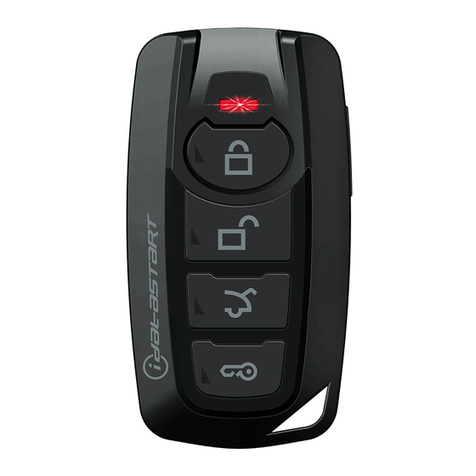
Automotive Data Solutions
Automotive Data Solutions iDatastart TR3450AF owner's manual

Directed Electronics
Directed Electronics 3000 owner's guide
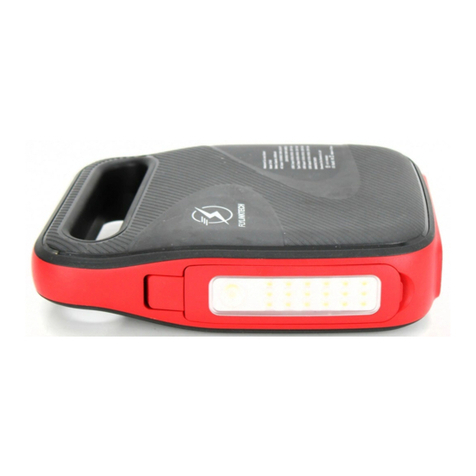
FLYLINKTECH
FLYLINKTECH CF400 user manual

Audiovox
Audiovox AS-9055 installation instructions

CrimeStopper
CrimeStopper EZEE START EZ-10 installation instructions
